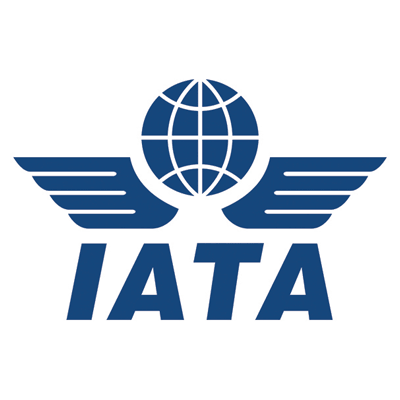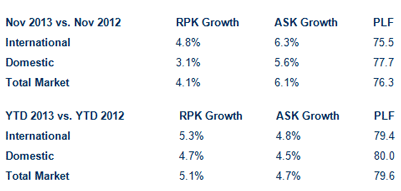Passenger demand moderates in November
- Like
- Digg
- Del
- Tumblr
- VKontakte
- Buffer
- Love This
- Odnoklassniki
- Meneame
- Blogger
- Amazon
- Yahoo Mail
- Gmail
- AOL
- Newsvine
- HackerNews
- Evernote
- MySpace
- Mail.ru
- Viadeo
- Line
- Comments
- Yummly
- SMS
- Viber
- Telegram
- Subscribe
- Skype
- Facebook Messenger
- Kakao
- LiveJournal
- Yammer
- Edgar
- Fintel
- Mix
- Instapaper
- Copy Link
Posted: 13 January 2014 | The International Air Transport Association | No comments yet
The International Air Transport Association announced global passenger traffic results for November 2013 showing a moderation in the pace of recent demand growth…


The International Air Transport Association (IATA) announced global passenger traffic results for November 2013 showing a moderation in the pace of recent demand growth. Total revenue passenger kilometers (RPKs) rose 4.1% compared to November 2012. This was slower than the 6.5% year-over-year growth recorded in October.In November capacity expanded by 6.1% which out-paced demand growth. This led to a 1.4 percentage point slip in the load factor to 76.3%.
Demand drivers such as consumer and business confidence, however, continue to improve. This suggests that growth may accelerate in the coming months.
“Demand growth hit a speed bump in November. But with continued modest improvements in economic conditions the outlook remains positive,” said Tony Tyler, IATA’s Director General and CEO.

International Passenger Markets
November 2013 international passenger demand was up 4.8% compared to the year-ago period. Capacity rose 6.3% versus November 2012 and load factor dipped 1.0 percentage points to 75.5%. All regions except Africa recorded year-over-year increases in demand. However, compared to October, all regions reported slower demand growth for November.
- Asia-Pacific carriers recorded an increase in demand of 5.5% compared to November 2012. This was supported by the stronger performance of major economies such as China and Japan. With capacity up 6.8% on the previous year, the load factor slipped 0.9 percentage points to 75.4%.
- European carriers’ demand for international services rose 4.1% in November 2013 compared to the year-ago period. Capacity expanded more quickly at 4.8% leading to a 0.5 percentage point dip in the load factor to 77%. Modest economic improvements and rising consumer and business confidence are supporting the growth in demand.
- North American airlines saw demand rise 1.7% over the 2012 period. This was a slowdown on October growth, which was 3.6%. Capacity rose 4.7%, causing load factor to fall 2.2 percentage points to 77.5%. Recent economic indicators have shown a solid fourth quarter, despite the disruption of the government shutdown in October.
- Middle East carriers had the strongest year-over-year demand growth at 9.7%. Airlines in the region have benefited from strong growth in business-related premium travel throughout the year, particularly to Africa and other developing markets. Capacity rose 12.8% and load factor slipped two percentage points to 72.1%.
- Latin American airlines experienced a 6.9% rise in demand in November, the second strongest growth recorded. Robust expansion in business related travel is being driven by the strong performance of economies such as Colombia, Peru and Chile. Capacity rose 3.6% and load factor climbed 2.4 percentage points to 79.4%, the highest for any region.
- Africa was the only region to see a decline in demand: November traffic fell 2% compared to the same month in 2012. Capacity climbed 2.6%, pushing load factor down 3 percentage points to 63.5%, by far the lowest for any region. Volatility in the air transport statistics rather than the start of a downward trend may have contributed to the lower number, as the demand environment is strong.
Domestic Passenger Markets
Demand for domestic travel rose 3.1% in November 2013 compared to the year-ago period, a significant deceleration versus the October increase of 5.9%. There was significant variation in performance among markets. Total domestic capacity was up 5.6% and load factor dipped 1.9 percentage points to 77.7%.
- US domestic traffic fell 1.2% in November versus November 2012. This most likely is linked to the timing of the Thanksgiving holiday nearer the end of the month, which caused some traffic associated with the holiday to slip into December.
- China’s domestic traffic jumped 9.3% compared to the year ago, the strongest performance for any market. The vibrant growth is consistent with the robust economic activity.
- Japan saw a 3.3% rise in domestic traffic for November year-over-year, supported by sustained increases in business activity and improving employment rates.
- Brazil’s domestic traffic rose 4.5%, the second consecutive month of solid performance after a difficult first three quarters of 2013.
- Indian domestic traffic rose 3.4% in November compared to a year ago, after an 8.6% rise in October, signaling that conditions remain volatile.
- Russia’s November domestic traffic climbed 9.2%. Demand for air travel is being supported by a resilient labor market in line with government policy to maintain high employment and sustained income levels.
- Australian domestic traffic slipped 1.0% as the economy remained sluggish with rising unemployment.
The Bottom Line:
On 1 January 2014, commercial aviation celebrated its 100th birthday. From one airplane, one passenger, one pilot and one route across Tampa Bay, Florida, the global airline industry now carries more than 8 million passengers on more than 80,000 departures each day and supports 57 million jobs.
“Aviation drives the global economy. We connect people and businesses to markets; and bring together friends and families. Aviation creates opportunities for greater cultural understanding and carries medicine and supplies to those in need. In a single century, the industry has had a transformative impact on the way in which we live and interact. And it has firmly established itself as a force for good in our world,” said Tyler.
“But aviation is also a team effort. Ensuring that the second century is as successful as the first requires the cooperation of stakeholders in both the public and private sectors. As we reflect on an amazing first hundred years, I hope that governments will take stock of the wide-reaching economic and social benefits of aviation-enabled connectivity. These far outstrip any short-term boosts to treasury revenues generated through taxes or fees,” said Tyler.
“It is ironic that in the United States – the country that gave birth to this amazing industry – political leaders in Washington agreed to raise taxes on air travelers to close the budget gap just a few days before we celebrated this momentous anniversary. How much better would it be if instead of seeing aviation and air travelers as easy targets for $12.6 billion in new taxes , they shared in the vision that guided the pioneers who created this industry,” Tyler said.
View November passenger traffic results (pdf)













